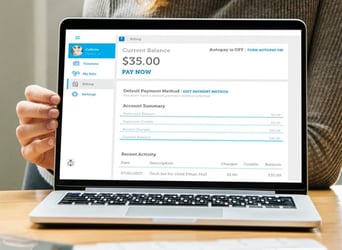
A well-structured daycare curriculum does more than keep children busy; it builds the foundation for thinking, learning, and growing. During the first five years of life, a child’s brain develops more rapidly than at any other time. In fact, 90% of brain growth happens before kindergarten (FTF, 2025). That’s why daycare providers play a critical role in early childhood development.
Research shows that high-quality early learning experiences, especially those that include play-based learning, support social, emotional, cognitive, and physical development (Yogman, Garner, Hutchinson, Hirsh-Pasek, Golinkoff, 2018). Children engaging in meaningful activities through the best daycare curriculum, like storytelling, sensory play, and peer interactions, form the building blocks needed for school readiness and lifelong learning.
This guide walks you through how to create an intentional, well-balanced curriculum for daycare. You’ll learn what a daycare curriculum includes, how to design it step by step, tools and templates you can use, legal requirements, and how to avoid common mistakes. We’ll also show you how Vanco’s Child Care Management Suite helps streamline the process and provides 100+ free templates to help you save time and money.
Table of Contents
- What Is a Daycare Curriculum?
- Core Elements of an Effective Daycare Curriculum
- How to Plan a Daycare Curriculum Step-by-Step
- Legal & Licensing Considerations in the USA
- Common Mistakes to Avoid
- How Our Child Care Management Suite Supports Curriculum Planning
- Final Thoughts
- 100+ Free Afterschool Program Templates to Save Time & Money
- FAQs
What Is a Daycare Curriculum?
A daycare curriculum is a structured plan for guiding children’s development through age-appropriate activities, routines, and interactions. Unlike a rigid academic syllabus, it allows for flexibility and creativity while supporting children’s growth in key developmental areas.
Daycare curricula often differ from preschool or kindergarten curricula, which may follow more academic goals. In daycare, the focus is on foundational skills through play, routines, and social experiences. The goal is to promote all aspects of a child’s emotional, physical, language, and cognitive development.
A strong curriculum for daycare should align with developmental milestones, meet state licensing and early learning standards, support each child’s unique learning style and pace, and provide program and classroom structure without limiting creativity. The goal is to create developmentally appropriate practices (DAP), which are defined by NAEYC (2020) as “methods that promote each child’s optimal development and learning through a strengths-based, play-based approach to joyful, engaged learning.”
Core Elements of an Effective Daycare Curriculum

Cognitive Development
The goal of cognitive development is to help children think, explore, and solve problems. Activities should encourage curiosity and early math and science skills. Sorting games, puzzles, and block-building help children recognize patterns and cause-and-effect relationships. Progress can be measured by how well a child completes tasks, solves simple problems, or follows sequences.
Social and Emotional Learning (SEL)
SEL supports a child's ability to understand and manage emotions, form healthy relationships, and make responsible decisions. Children get SEL through group games, role-playing, and books about feelings. A child who expresses emotions appropriately and cooperates with others is progressing well.
Physical Development
Physical development includes both gross and fine motor skills.
- Gross motor activities involve running, climbing, and balancing
- Fine motor tasks include lacing beads, using scissors, and stacking blocks
Caregivers can track improvements by noting coordination, balance, and dexterity changes.
Language and Communication
Language development builds the foundation for reading, writing, and social interaction. Singing, storytime, and daily conversations help expand vocabulary and communication skills. Children should be able to follow directions, use simple sentences, and engage in verbal exchanges.
Creativity and Exploration
Creativity encourages imagination and self-expression. Art projects, pretend play, and sensory activity stations let children explore materials and ideas in open-ended ways. A child engaged in these activities will show increasing independence, originality, and confidence.
How to Plan a Daycare Curriculum Step-by-Step
Step 1: Set Developmental Goals
Start by identifying developmental goals based on the ages of children in your care. Use resources like state early learning guidelines and CDC developmental milestone checklists. Focus on social, emotional, cognitive, physical, and language skills.
Establishing clear, meaningful goals provides structure and purpose, setting the foundation for a thoughtful, responsive curriculum. To set developmental goals:
- Consider how the goals align with each child's age, background, and learning style.
- Collaborate with families to understand individual needs and tailor objectives accordingly.
- Be specific as you define what success looks like and how progress will be measured.
- Goals should also be inclusive, not just for abilities, but for learning styles and preferences in interacting with others. In 2019, NAEYC outlined how focusing on creating equitable and inclusive early learning curricula and environments can counteract bias while supporting all children.
Step 2: Map Out Weekly & Monthly Themes
Use themes to organize your curriculum and make learning fun. Common themes include seasons, animals, colors, community helpers, and cultural holidays. A sample calendar might start with:
- January: Winter Weather, Hibernation
- February: Friendship, Transportation
- March: Spring, Gardening
Step 3: Design Daily Routines and Lesson Plans
Structure each day with a mix of activities and transitions. A daycare curriculum example provides a balanced daily routine including:
- Circle time: A time when children come together to practice some basic skills in a fun way, like counting, days of the week, or even sharing a story.
- Free play: This time allows children to explore their surroundings and choose their activities.
- Meals and snacks: Healthy options and a variety of meals each week can help children explore new foods.
- Outdoor play: Physical movement and interacting with nature are essential.
- Storytime: The teacher explores a book or story with students as a small or large group.
- Nap or quiet time: Some quiet or downtime allows children to rest and ground themselves.
Each lesson plan should include objectives, materials needed, and instructions.
Step 4: Include Assessments and Observations
Track each child’s growth through informal observations, checklists, and portfolios. Take notes on their participation, skills demonstrated, and areas needing support. Use this data to adjust your teaching strategies. Creating a portfolio for each child with samples of work each week or month is an excellent way to show parents growth and spot any potential issues throughout the year. You can also choose to use checklists to show if children are meeting developmental and learning milestones.
Using assessments and observations is useful to teachers and coordinators, and can be highly beneficial to parents who want to know how their children are progressing and if any issues need to be addressed. Additionally, assessments and observations are a way to share objectives and parts of the curriculum with parents and caregivers. This can help families feel more involved in the educational process. According to the PFCE Framework from the Office of Head Start (2018), early childhood programs can easily partner with families to support child development stages and overall learning.
Legal & Licensing Considerations in the USA
Each state has its own regulations for licensed daycare providers. Most require:
- A developmentally appropriate curriculum
- Activities covering all major learning domains
- Age-specific staff-to-child ratios
- Documentation of daily activities and learning goals
To ensure compliance, consult your state’s regulations. Child Care Aware of America offers state-by-state resources.
In addition to curriculum requirements, providers must also adhere to other rules, including:
- Health and safety standards, including sanitation procedures, emergency preparedness plans, and staff background checks
- Some states may require continuing education hours for caregivers to ensure staff stay current on best practices
- Proper documentation of immunizations, incident reports, and attendance records
Non-compliance can lead to penalties, license suspension, or closure, so it’s critical to stay informed and up to date. Consider joining a local childcare association or subscribing to your state’s licensing updates to stay ahead of regulatory changes and maintain a high-quality program.
Common Mistakes to Avoid
Avoid common pitfalls when planning your curriculum. These include:
- Overloading the schedule with structured activities and not enough free play
- Ignoring different learning styles and needs
- Failing to track and respond to children’s developmental progress
- Failing to leave room for extended activities and always having a backup when an activity ends early
How Our Child Care Management Suite Supports Curriculum Planning
Our Child Care Management Suite is designed to support daycare providers with every aspect of curriculum planning. Key features include:
- Ready-to-use lesson plan templates
- Child development tracking tools
- Staff communication boards
- Parent engagement portals
You can plan lessons, record observations, and share updates with families from one platform.
Final Thoughts
Designing a daycare curriculum is both an art and a science. As you’ve seen, a strong curriculum isn’t just a list of activities — it’s a purposeful plan that nurtures a child’s mind, body, and spirit. From setting developmental goals and choosing thoughtful weekly themes to building flexible routines and using observational assessments, every step in the process matters.
By centering your curriculum around the core areas of development — cognitive, social-emotional, physical, language, and creative — you provide children with a balanced learning experience that builds their confidence, independence, and readiness for the next stage in life. A well-designed daycare curriculum helps children thrive not just in the classroom, but far beyond it.
Intentionality is key. When you design with purpose, you’re not just planning your week; you’re shaping lifelong learners. Whether you’re just starting out or fine-tuning your approach, using the right tools can make all the difference. Our Child Care Management Suite is built to support every step of your planning process, so you can spend less time on paperwork and more time doing what matters most: engaging with children.
And if you're feeling overwhelmed or unsure where to begin, don’t worry — we’ve got you covered. Check out our free resource pack with over 100 ready-made templates. These time-saving tools include everything from lesson plans and activity planning calendars to sign-in sheets and communication forms, giving you everything you need to build, organize, and elevate your daycare curriculum.
Ready to streamline your planning and spark inspiration? Dive into the toolkit and take your curriculum from good to great.
100+ Free Afterschool Program Templates to Save Time & Money
Need help getting started? Download our free toolkit with over 100 after-school program templates. You’ll find lesson plan outlines, activity ideas, daily schedules, enrollment forms, and more. It’s a time-saving solution for busy directors and educators.
Get your free kit here: Download Now
FAQs
What should be included in a daycare curriculum?
A daycare curriculum should include age-appropriate activities that support development in five key areas: cognitive, physical, language, social-emotional, and creative exploration.
How do I create a curriculum for infants and toddlers?
Focus on sensory play, routines, and bonding experiences. Activities should be hands-on and flexible, with an emphasis on motor development and early communication.
What’s the difference between daycare and preschool curriculum?
Daycare emphasizes foundational skills and routines, while preschool typically starts to build children’s academic readiness. Both share the goal of promoting development across multiple domains.
How can I align my curriculum with state standards?
Use your state’s early learning guidelines as a checklist. Many offer goal-setting templates and example activities by age group.
What are the best educational philosophies for daycare settings?
Popular approaches include Montessori, Reggio Emilia, and play-based, child-centered learning. Choose one that aligns with your values and the needs of your children.
How much structure should a daycare schedule have?
There should be a balance between structured and unstructured time. Predictable routines help children feel secure, while free play supports creativity and social learning.
How often should I update my daycare curriculum?
Update your curriculum at least quarterly or when transitioning to a new age group. Make adjustments based on observations and developmental assessments.
What are good themes for daycare lesson plans?
Themes like "Under the Sea," "My Family," "Colors and Shapes," "Weather," and "All About Me" are popular and engaging for young children.
How do I track developmental progress effectively?
Use observation notes, developmental checklists, and portfolios. Regular parent-teacher conferences can also help track and share progress.
Can software help with daycare curriculum planning?
Yes. Childcare software can store lesson plans, track milestones, and communicate with parents, saving time and improving quality.










